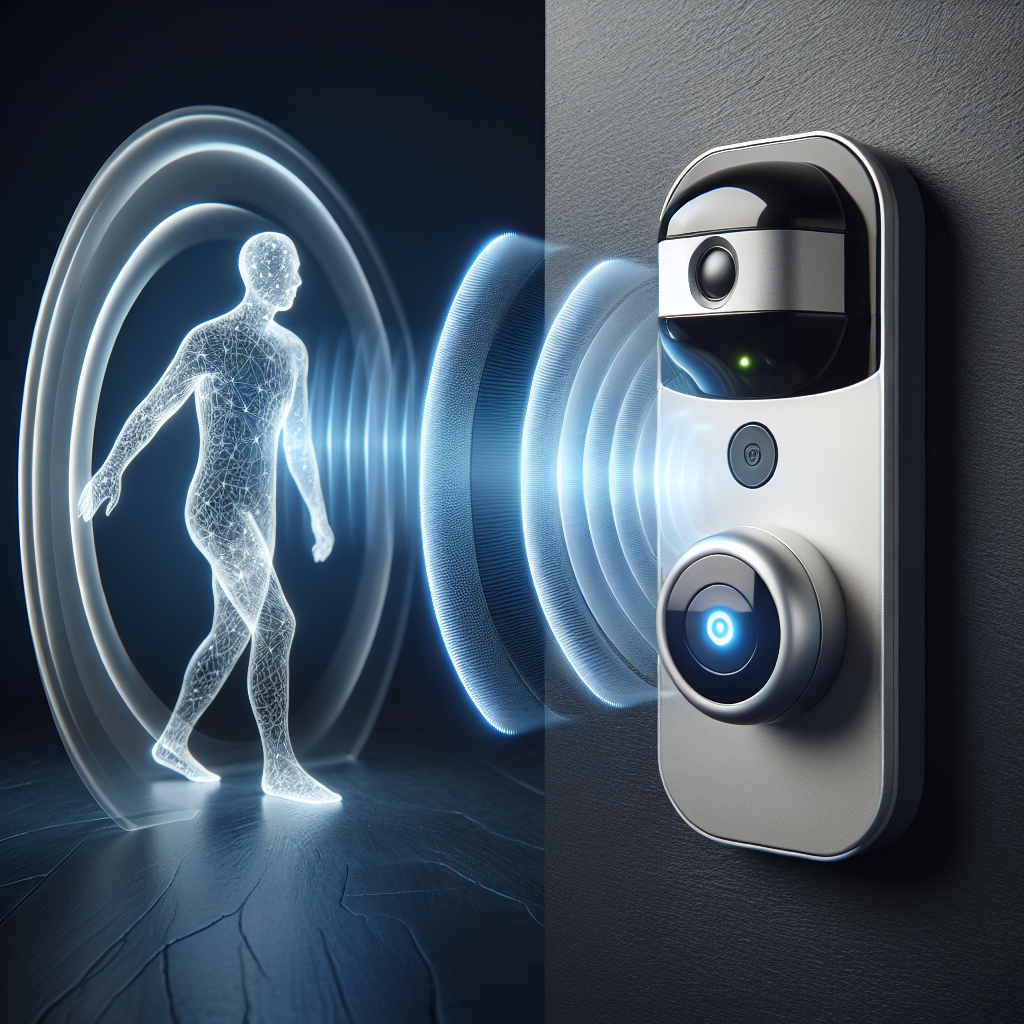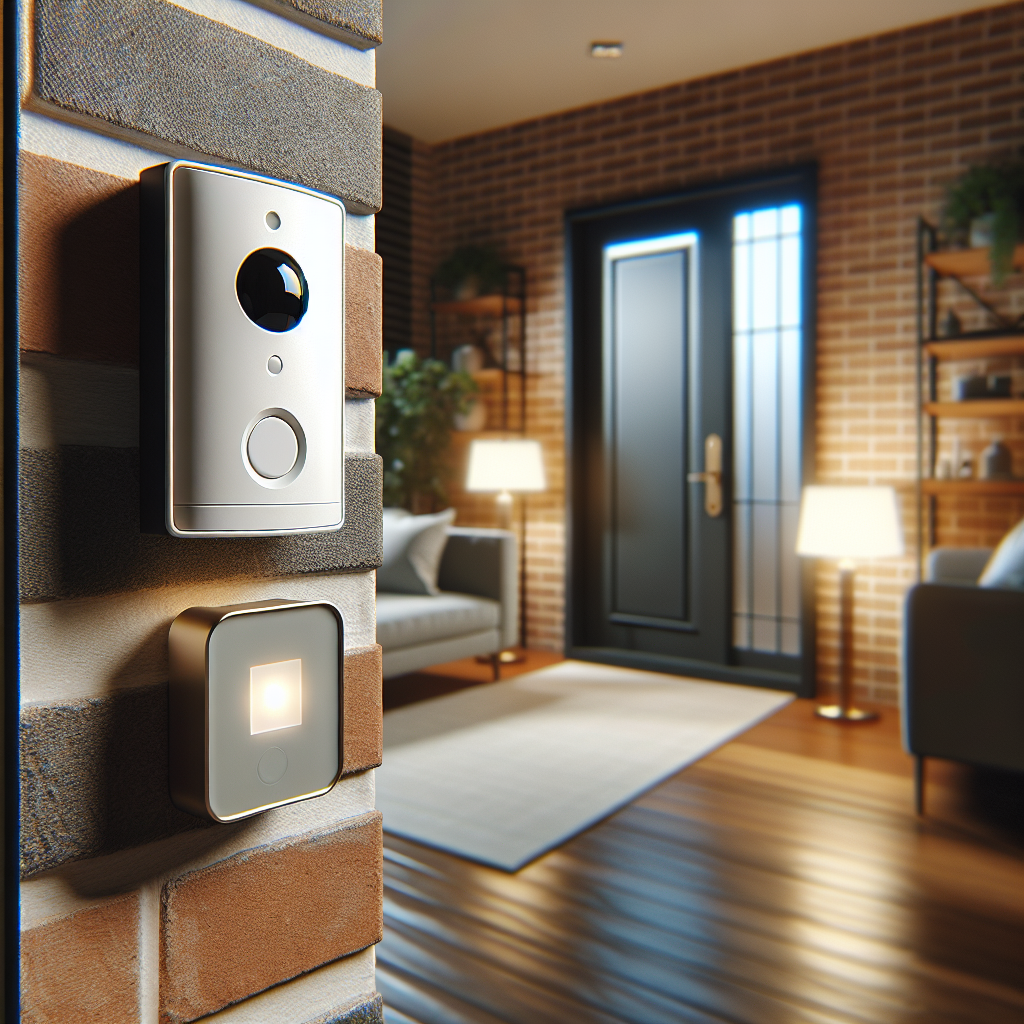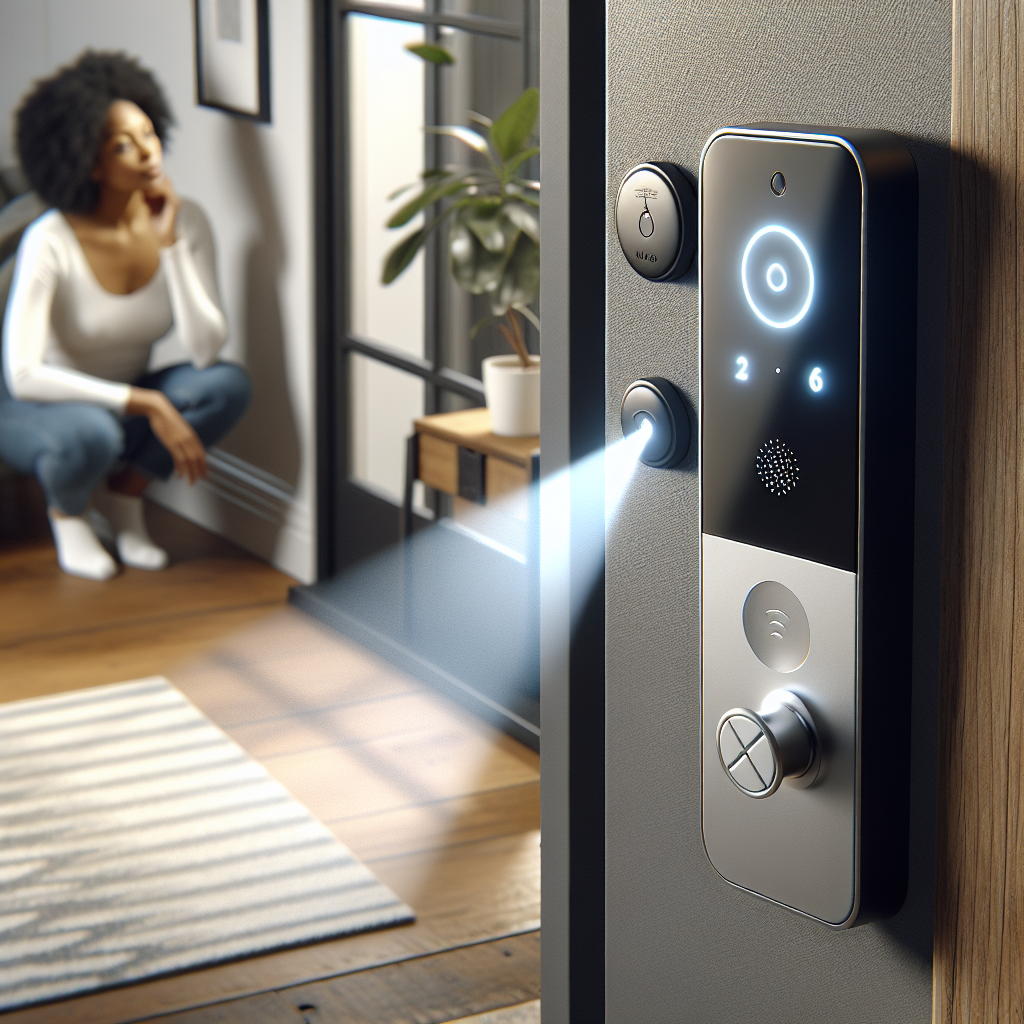Upgrade your home security with the latest in innovative technology – the motion sensor with audible doorbell. This cutting-edge device not only detects movement around your property but also alerts you with a clear, loud chime whenever someone approaches your front door. Say goodbye to unexpected visitors and potential intruders with this advanced system that provides peace of mind and added protection for you and your family. With easy installation and customizable settings, the motion sensor with audible doorbell is the perfect solution for enhancing your home’s security measures. Stay one step ahead and invest in your safety today!
Understanding Motion Sensors in Home Security Systems

Motion sensors play a crucial role in enhancing the security of homes by detecting any movement within their vicinity. These sensors are designed to trigger an alert or alarm when motion is detected, helping homeowners to be aware of potential intruders or unexpected visitors.
Definition and function of motion sensors
- Motion sensors are electronic devices that are capable of detecting movement in their designated area of coverage.
- They work by sensing changes in heat, sound, or vibration, depending on the type of sensor technology used.
- When motion is detected, these sensors send a signal to the connected alarm system or device, activating a response such as sounding an alarm or sending a notification.
Types of motion sensors used in home security
Passive Infrared (PIR) sensors
- PIR sensors are the most common type of motion sensors used in home security systems.
- They detect infrared radiation emitted by objects in their field of view and are triggered when there is a significant change in this radiation.
- PIR sensors are ideal for detecting human movement and are often used in indoor settings.
Microwave sensors
- Microwave sensors emit microwave pulses and measure the reflection of these pulses to detect motion.
- They are more sensitive to movement and can penetrate through walls and other obstacles.
- Microwave sensors are suitable for outdoor use and can cover a larger area compared to PIR sensors.
Dual-technology sensors
- Dual-technology sensors combine two different sensor technologies, such as PIR and microwave, for enhanced accuracy and reliability.
- By requiring both sensors to be triggered simultaneously, false alarms due to environmental factors like pets or moving objects are minimized.
- Dual-technology sensors are commonly used in high-security applications where reliability is paramount.
How Motion Sensors Detect Movement
Motion sensors detect movement through a variety of methods, with the most common being passive infrared (PIR) technology. This technology works by detecting changes in heat signatures within its field of view. When a warm object, such as a person or an animal, moves across the sensor’s range, it causes a shift in infrared energy, triggering the sensor to activate.
Another method of detecting movement is through microwave technology. Microwave sensors emit continuous waves and measure the reflection of these waves off objects in their range. When an object moves within the sensor’s field, it disrupts the microwave signals, prompting the sensor to register motion.
Some motion sensors also utilize dual-technology, which combines both PIR and microwave technologies for enhanced detection accuracy. By using multiple detection methods, these sensors can reduce false alarms caused by environmental factors.
Ultrasonic sensors are another type of motion detection technology that emits high-frequency sound waves and measures their reflection off objects. When an object moves within the sensor’s range, it alters the sound wave patterns, triggering the sensor to respond.
Each of these technologies has its own strengths and weaknesses, making them suitable for different home security applications. Factors such as the layout of the home, the presence of pets, and the desired level of sensitivity can influence the choice of motion sensor technology.

The Role of Audible Doorbells in Home Security
Importance of Audible Alerts in Notifying Homeowners
- Audible doorbells play a crucial role in home security by providing immediate alerts to homeowners when someone approaches or enters their property.
- These alerts are essential for ensuring that homeowners are aware of any activity around their home, even when they are in a different part of the house.
- By promptly notifying occupants of visitors or potential intruders, audible doorbells help homeowners take necessary actions to secure their property.
Benefits of Audible Doorbells Over Traditional Doorbells
- Enhanced Security: Unlike traditional doorbells that rely solely on visual cues, audible doorbells add an extra layer of security by audibly signaling the presence of someone at the door.
- Deterrence of Intruders: The prominent sound of an audible doorbell can act as a deterrent to potential intruders, making them think twice before attempting unauthorized entry.
- Accessibility for Hearing-Impaired Individuals: Audible doorbells cater to the needs of hearing-impaired individuals who may not be able to rely on conventional doorbells that produce only visual alerts.
Features of Audible Doorbells in Motion Sensor Systems
-
Integration of motion sensors with audible doorbells:
The integration of motion sensors with audible doorbells enhances home security by providing a proactive alert system. When motion is detected in the designated area, the audible doorbell is triggered, alerting homeowners of potential activity near their property. This integration ensures that residents are immediately notified of any movement around their home, even before someone reaches the door. -
Customization options for alert sounds:
Audible doorbells in motion sensor systems offer customization options for alert sounds, allowing homeowners to choose a sound that suits their preferences and alerts them effectively. Whether it’s a traditional doorbell chime, a loud alarm, or a soothing melody, the ability to customize alert sounds adds a personal touch to the home security system. This feature enables residents to differentiate between regular visitors and potential intruders based on the sound of the alert. -
Volume control and range of audible alerts:
Motion sensor systems with audible doorbells provide volume control settings, ensuring that homeowners can adjust the sound to suit their surroundings and preferences. Whether it’s a quiet evening at home or a busy day with noise in the background, the ability to control the volume of the audible alerts ensures that the notifications are always heard. Additionally, the range of audible alerts can be tailored to the size of the property, ensuring that residents can hear the alerts from various locations within their home.
Advantages of Using Motion Sensor with Audible Doorbell
- Immediate notification of approaching individuals
Motion sensors with audible doorbells provide homeowners with the immediate advantage of being alerted when someone approaches their property. The sensor detects movement within its range and triggers the audible doorbell, alerting those inside the home. This instant notification allows residents to be aware of any potential visitors or intruders near their property, enhancing overall security measures.
- Seamless integration with existing security systems
One of the key advantages of utilizing a motion sensor with an audible doorbell is its ability to seamlessly integrate with existing security systems. Homeowners can easily incorporate this technology into their current setup without the need for extensive modifications or installations. This integration ensures that the motion sensor enhances the overall effectiveness of the security measures already in place, providing a comprehensive approach to home security.
- Improved responsiveness to potential security threats
By having a motion sensor with an audible doorbell in place, homeowners can significantly improve their responsiveness to potential security threats. The audible alert serves as a proactive measure to deter intruders and notify residents of any suspicious activity. This heightened level of responsiveness allows homeowners to take immediate action in the event of a security breach, increasing the overall safety and protection of the property.
Addressing Common Misconceptions about Motion Sensor Audible Doorbells
- Myth: Motion sensors are easily triggered by pets or wildlife
Contrary to popular belief, modern motion sensor technology has advanced significantly, allowing for customizable sensitivity settings. This means that homeowners can adjust the sensor’s range and sensitivity to avoid false alarms triggered by pets or wildlife. Additionally, some motion sensors are equipped with pet-immune features that can distinguish between the movement of a pet and that of an intruder, further reducing the likelihood of false alarms.
- Myth: Audible doorbells are unnecessary for homes with existing security measures
While it may seem redundant to have an audible doorbell in a home already equipped with security measures such as cameras or alarms, audible doorbells play a crucial role in enhancing home security. They provide an immediate alert when someone approaches your door, even if they have not yet triggered other security systems. This early warning system can deter potential intruders and give homeowners a chance to prepare or react promptly to any suspicious activity.
- Clarification on the effectiveness of motion sensor audible doorbells

Motion sensor audible doorbells are not standalone security devices but rather components of a comprehensive home security system. When integrated with other security measures, such as cameras, alarms, and smart locks, motion sensor audible doorbells act as the first line of defense, detecting and alerting homeowners to any movement near entry points. This proactive approach to home security can help prevent break-ins and provide peace of mind to homeowners, knowing that their property is being monitored effectively.
Installation and Maintenance of Motion Sensor Audible Doorbell Systems
Installing a motion sensor with an audible doorbell is a crucial step in enhancing home security. Follow this detailed guide for a seamless setup and upkeep of your system:
Step-by-step Guide for Installing a Motion Sensor with Audible Doorbell
-
Selecting the Location: Choose a strategic location near the entrance but out of reach from potential tampering. Ensure it covers the desired area without being triggered by passing vehicles or pets.
-
Mounting the Sensor: Use the provided mounting hardware to secure the sensor in place. Adjust the angle for optimal coverage and test different heights to avoid false alarms.
-
Connecting the Doorbell: Follow the manufacturer’s instructions to link the motion sensor to the audible doorbell. Test the connection by triggering the sensor within range.
-
Adjusting Settings: Fine-tune the sensitivity and range settings to suit your home’s layout. Avoid pointing the sensor towards reflective surfaces or sources of heat to prevent false alerts.
Tips for Optimal Sensor Placement for Maximum Coverage
-
Height Matters: Mount the sensor at a height of 6-7 feet for ideal motion detection range.
-
Avoid Obstructions: Keep the sensor clear of obstacles like plants, furniture, or decorations that may obstruct its view.
-
Multi-Angle Placement: Consider installing sensors at different angles to cover blind spots and ensure comprehensive surveillance.
Routine Maintenance Practices to Ensure System Functionality
-
Regular Testing: Periodically test the sensor and doorbell to verify they are functioning correctly.
-
Battery Check: If your system is battery-operated, check and replace batteries as needed to prevent downtime.
-
Cleaning: Keep the sensor lens clean from dust, dirt, or debris that could interfere with motion detection.
-
Firmware Updates: Stay updated with the latest firmware releases from the manufacturer to enhance system performance and security features.
Troubleshooting and Technical Support for Motion Sensor Audible Doorbells
When it comes to troubleshooting and seeking technical support for motion sensor audible doorbells, it’s essential to be equipped with the right knowledge and resources to address any issues promptly. Here are some key points to consider:
- Common Issues with Motion Sensor Audible Doorbells
- Inconsistent detection of motion: Sometimes, the motion sensor may fail to detect movement accurately, leading to delayed or missed alerts.
- False alarms: Erroneous triggers can be frustrating and may be caused by environmental factors or improper sensor placement.
-
Connectivity problems: Issues with the doorbell’s connection to the audible chime or the mobile app can hinder its functionality.
-
Troubleshooting Methods for Resolving Technical Problems
- Check the sensor placement: Ensure that the motion sensor is positioned correctly and is free from obstructions that could impede its detection capabilities.
- Adjust sensitivity settings: Fine-tuning the sensitivity levels of the motion sensor can help reduce false alarms while ensuring accurate motion detection.
-
Test connectivity: Verify that the doorbell is properly connected to the audible chime and that the mobile app, if applicable, is functioning correctly.
-
Contact Information for Technical Support and Assistance
- Manufacturer’s customer support: Reach out to the product manufacturer for specialized assistance and guidance on troubleshooting and resolving technical issues.
- Online forums and communities: Explore online forums and communities dedicated to home security systems to seek advice from other users who may have encountered similar problems.
- Professional installation services: Consider consulting with professional technicians who specialize in home security systems to diagnose and address any complex technical issues effectively.
FAQs for Motion Sensor with Audible Doorbell for Enhanced Home Security
What is a motion sensor with audible doorbell?
A motion sensor with audible doorbell is a security device that combines a motion sensor and a doorbell functionality. When the motion sensor detects movement outside your home, it triggers the audible doorbell to alert you of any potential visitors or intruders. This can provide an extra layer of security and peace of mind for homeowners.
How does a motion sensor with audible doorbell help enhance home security?
A motion sensor with audible doorbell helps enhance home security by providing a proactive alert system for any movement outside your home. The audible doorbell can alert you in real-time when someone approaches your property, allowing you to take appropriate action if needed. This can help deter potential intruders and provide a sense of safety for you and your family.
Are motion sensors with audible doorbells easy to install?
Most motion sensors with audible doorbells are designed to be easy to install and set up. They typically come with mounting hardware and instructions for hassle-free installation. In most cases, you can simply mount the motion sensor near your front door and place the audible doorbell inside your home within range. It’s recommended to follow the manufacturer’s instructions for proper installation and testing of the device.
Can a motion sensor with audible doorbell be customized to suit my home security needs?
Many motion sensors with audible doorbells offer customizable settings to suit your home security needs. You may be able to adjust the sensitivity of the motion sensor, set different chime tones for different zones, or even connect the device to a smartphone app for remote monitoring. It’s important to check the features and capabilities of the specific model you choose to ensure it meets your security requirements.